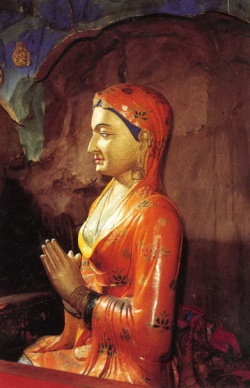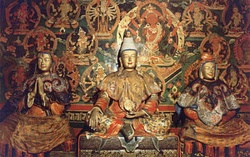Bhrikuti
The Nepali Princess Bhrikuti Devi, known to Tibetans as Bal-mo-bza Khri-btsun, Bhelsa Tritsun ('Nepali consort') or, simply, Khri bTsun ("Royal Lady"), is traditionally considered to have been the first wife of the earliest emperor of Tibet, Songtsän Gampo (605? - 650 CE), and an incarnation of Tara. She was also known as "Besa", and was a princess of the Licchavi kingdom of Nepal.
Even though the historicity of Bhrikuti Devi is not certain, and no reference to her has been found among the documents discovered at Dunhuang, "there are increasing indications supporting this hypothesis." There were certainly very close relationships between Tibet and Nepal at this period and, "Such a mythological interpretation discredits in no way the historical likelihood of such a marriage...."
Many Tibetan accounts make Bhrikuti the daughter of Amshuvarma (605-621 CE), co-ruler and successor of Śivadeva I. If this is correct, the marriage to Songtsän Gampo must have taken place sometime before 624 CE. Acharya Kirti Tulku Lobsang Tenzin, however, states that Songsten Gampo married Bhrkuti Devi, the daughter of king "Angsu Varma" or Amshuvarma (Tib: Waser Gocha) of Nepal in 632.
According to some Tibetan legends, however, a Nepali king named Go Cha (identified by Sylvain Lévi as "Udayavarman", from the literal meaning of the Tibetan name, who was said to have a daughter called Bri-btumn or Bhṛkuti.
"Udayavarman" was, most likely the same king we know as Udayadeva (the son of Śivadeva I and, later, adopted son and heir to Aṃshuvarmā), and the father of Narendradeva (Tib: Miwang-Lha). If this is accepted, it means that Narendradeva and Bhrikuti Devi were brother and sister. Whatever the case, if the marriage did take place, it must have been sometime in the early 620s.
We do have some fairly detailed historical accounts of Narendradeva, who not only spent some time as an exile in Tibet, but was placed on the Nepalese throne with the help of the Tibetans.
The (Jiu) Tangshu, or Book of Tang, records that when the king of 泥婆羅 Nipoluo Nepal, the father of Licchavi king Naling Deva (or Narendradeva), died, an uncle (Yu.sna kug.ti = Vishnagupta) usurped the throne. "The Tibetans gave him refuge and reestablished him on his throne [in 641]; that is how he became subject to Tibet."
It is not known exactly when Bhrikuti married Songtsän Gampo, but it was presumably about the time that Narendadeva fled to Tibet after his father, Udayadeva, was replaced by Dhruvadeva c. 621 CE, who, according to an inscription dated in 623, was ruling jointly with Jiṣṇugupta.
Bhrikuti in Tibet
This is considered to be the oldest copy of the famous traditional history, the dBa' bzhed, states:
- "Then during the reign of bTsan po Khri Srong btsan, after his marriage with Khri btsun, the daughter of the king of Nepal, the temple (gtsug lag khang) of Ra sa [Lhasa] Pe har gling was built. Furthermore, the construction of the forty-two temples of the Ru bzhi was requested and the Brag lha [temple] was built. 'Thon mi gSam po ra was sent by royal order [to India] in order to get the Indian doctrine and the model of the alphabet (yi ge'i dpe). . . ."
According to Tibetan traditions, Bhrikuti was a devout Buddhist and brought many sacred images and expert Newari craftsmen with her as part of her dowry. The Red Palace (Mar-po-ri Pho-drang) on Marpo Ri (Red Mountain) in Lhasa, which was later rebuilt into the thirteen storey Potala by the Fifth Dalai Lama, was constructed by Nepali craftsmen according to her wishes. She also had constructed the Tub-wang and other statues in Samye and the famous Nepali artist Thro-wo carved the revered statue of Chenresig, Thungji Chen-po rang-jung nga-ldan. It is also called statue of Mikyo Dorje (Manuvajra) - the Ramoche Jowo or Jowo Chungpa which was housed in the Ramoche Temple in Lhasa. It seems unlikely that the statue there now is the original one brought by the Nepali princes as the temple has been sacked at least two times - first during the Mongol invasions and later it was gutted in the 1960s. It is said that the lower half of the statue was found in a Lhasa rubbish dump and the upper part found in Beijing. They have been since joined together and the statue is surrounded by the Eight Bodhisattvas.
Songtsän Gampo and Bhrikuti built a great temple, the Tsulag Khang (or 'House of Wisdom') to house the images, which is now known as the Jokhang ('House of the Lord') in the heart of Lhasa, and is considered to be the most sacred temple in Tibet. They also built the white palace of dMar-po-ri which shifted the ancient seat of government in the Yarlung Valley to the site of modern Lhasa.
Bhrikuti is usually represented as Green Tara in Tibetan iconography. Songtsän Gampo also married the Chinese Princess Wencheng, who is considered to be another incarnation of Tara (White Tara), in 641 CE, and Bhrikuti and Wencheng are said to have worked together to establish temples and Buddhism in Tibet.
Bhrikuti (Skt. Bhṛkutī; Wyl. lha cig khri btsun) was the Nepalese princess who married Songtsen Gampo and played an important role in the construction of the Jokhang. She arrived in Lhasa in either 632 or 634.
Atisha says in the Ka khol ma that, one morning king Songtsen Gampo said to his ministers Thönmi Sambhota and Gartong Tsen, as they were walking into his room, “Give me some chang,” and then added, “Last night, I dreamed of the Western land of Nepal, of a beautiful princess named Brhikuti, and the city of Yabu Yagal[1].". The next day the two ministers met near O Thang lake with the chieftains of the Seven Cities. They had asked the chiefs to bring some food, and they each brought different parts which, together, constituted a complete animal. This was considered a very auspicious sign, and they decided to invite the princess. Thönmi Sambhota and Gartong Tsen then left for Nepal, together with a hundred horsemen carrying numerous gifts as well as gold. Songtsen Gampo also gave them three letters in case the Nepali King Amshuvarman refused to accede to his request.
When they arrived in Nepal they met with the king. Gartong Tsen offered the gifts and asked for the princess for the king of Tibet, while Thönmi Sambhota acted as translator. The king of Nepal flew into a terrible rage and told them, “You are insulting me greatly! I will only give my daughter to someone of my own rank and I am superior to the king of Tibet: I have the holy Dharma and supports of the Buddha's body, speech and mind from the time of Buddha Kashyapa. The Dharma has been well established here since king Kri Kri, who reigned at the time of the Buddha Shakyamuni. My riches are like the smoke of the eternal fire, plates are never empty of food, the sound of flour mills never ceases. In Tibet, the king of the hungry ghosts, doesn't have all this, and since there is no law, thieves reign and battles rage. I won't give him my daughter!”
Each time he refused the minister presented him with another letter, written in Nepali in gold on blue paper. At length, the king gave the princess, together with the statues of Jowo Mikyö Dorje (a representation of Buddha Akshobhya) and Maitreya, the texts Tog, Gra lnga [2], and the Sutra of the White Lotus, as well as several artists and seven elephants loaded with precious diamonds. The princess herself rode on an elephant, holding a sandalwood statue of Tara, and surrounded by her many servants. The king went in person to see her off, he went as far as Mangyul, on the border of Nepal and Tibet.
Footnotes
- ↑ Wyl. ya 'bu ya 'gal, is the old Tibetan name for Kathmandu.
- ↑ Kangyur mdo mang vol.Kha (Dergé Edition)

